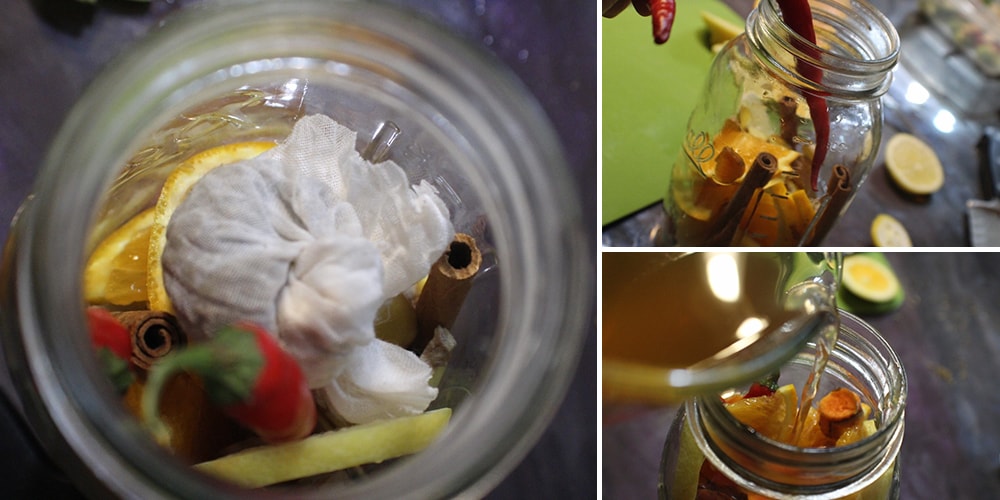
Illness Protection Potion
Fall is the time of year to start getting ready for the approaching cold and flu season. Fortunately, you can use the remnants of a well-rounded garden to make a fantastic illness protection potion. And if you don’t have a garden, no worries, these natural germ-fighting ingredients are easy to find anywhere.
How to Protect Yourself Against the Cold and Flu Season
People get sick during colder months for a couple of reasons. One is that everyone is cooped up inside in close proximity to each other. Another reason is that fall ushers in one sugar-filled holiday after another. No wonder we ring in the new year about five to ten pounds heavier and with the sniffles. Both sugar and overconsumption can wreak havoc on the immune system, making your body a prime target for every virus, bacteria, or superbug that enters your vicinity.
So, what’s the answer? Does this mean you shouldn’t partake in the festivities? Of course not! Even if you eat really well, there’s a chance that occasionally, a rogue germ will make it past your defenses and take hold. While being conscious of the amount of sugar and unhealthy foods you consume during the holidays will undoubtedly help, there are some natural herbs and superfoods you can combine to create a potent cold and flu remedy that’ll help fight those pesky seasonal germs, too.
Cold and Flu-Fighting Ingredients
Below is a list of the ingredients you’ll need for making your illness protection potion, along with details about each one’s health-giving characteristics. If you’re a gardener, many of these ingredients grow in your garden all the way up to early autumn. The rest can easily be found at your local health food store.
Apple Cider Vinegar – Raw apple cider vinegar contains a ‘mother,’ a mixture of probiotic bacteria that help boost immunity and fight off symptoms of the common cold and flu. It also contains elevated numbers of health-giving antioxidants and polyphenols.
Horseradish Root – the strong sinus-clearing ability of horseradish is apparent every time you take a bite of the fresh root, and it’s been used in that way for hundreds of years. But it’s also a super potent antibacterial agent, which competes with antibiotics to kill harmful bacterial strains like E.coli, H. pylori, and salmonella.
Turmeric Root – can help with both respiratory infections and asthma symptoms. It’s also well known for boosting the immune system and fighting inflammation and pain that sometimes accompany cold and flu. Its primary chemical component, curcumin, is known to have therapeutic and preventive potential against a number of chronic diseases.
Rosemary – is not only antimicrobial but it’s often used to help relieve pain and spasms and may help with the initial stages of nausea and indigestion. It’s also been shown to neutralize food-borne pathogens like Listeria monocytogenes, B. cereus, and S. aureus.
Thyme – Thyme can be helpful for conditions like coughs, bronchitis, colds, and asthma. Thyme is a common remedy for digestive discomfort since it relaxes the smooth muscles of the stomach and digestive tract. It’s antimicrobial and antiviral with a particular affinity for killing throat-dwelling bacteria and can be helpful in reducing cold and flu symptoms and bacterial infections like streptococcus.
Oregano – Fever and symptoms of the flu and cold have historically been managed using oregano. Its analgesic properties imply that it may be able to ease uncomfortable flu symptoms, including body pains or sore throats. One of oregano’s key constituents, carvacrol, is effective against viruses, especially respiratory and flu viruses.
Ginger – Ginger has long been used to promote better digestion, lessen feelings of nausea, and help the body fight influenza and the common cold. Additionally, it works as an antioxidant and aids in the body’s detoxification process, which improves the elimination of an infection. It can also lessen swelling and treat a sore throat.
Garlic – Garlic is great for enhancing immune function and fighting germs and bacteria associated with viruses, colds and flu by boosting the body’s white blood cell count. It can prevent you from getting sick in the first place.
Cinnamon – Cinnamon has been reported to play a role in clearing mucus and congested airways. It contains antioxidants that fight infection and inflammation.
Citrus – Oranges and lemons are both high in anti-inflammatory flavonoids, antioxidant vitamin C, and quercetin, which has been shown to reduce the duration of colds and flu dramatically.
Cayenne pepper – Cayenne is anti-microbial, pain relieving, cough reducing and mucus clearing. It can lessen the severity of a cold or flu. It also warms the body, increasing immunity and fighting the chills.
Raw Honey – Honey is antibacterial, antimicrobial, and antiseptic. (Do not give honey to children under 1 year old.)
⇒ Doctors Soak What Flower in Vinegar To Fight Infections Naturally? (Video)
Illness Protection Potion Recipe
This recipe is similar to “fire cider,” except it has more herbs, which address a wider range of wintertime illnesses. One whole rosemary, thyme, and oregano sprig may be used in place of each of the dried herbs. Gather all your ingredients and supplies.
You will need: 
- 1 Quart size jar
- 2 whole cayenne peppers
- 3 whole turmeric roots
- ½ Ginger root
- 5 – 6 whole garlic cloves
- 3 – 4 whole cinnamon sticks
- 3 cups Apple cider vinegar; more or less to cover ingredients in the jar
- ½ teaspoon dried rosemary
- 1 teaspoon of dried thyme
- 1 organic lemon
- 1 organic orange
- ½ teaspoon of dried oregano
- 6 – 8 piece of horseradish root
- ¼ cups raw unfiltered honey
Steps:
Step 1. All of the whole ingredients (peppers, herbs, roots, citrus fruits, etc.) should be rinsed and dried. I peeled the horseradish, but not the ginger or turmeric. Start adding the roots (turmeric, ginger, and horseradish) to the jar by slicing them into disks that are 1/8 inch thick.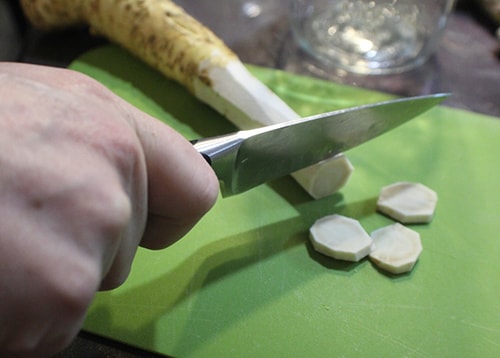
Step 2. Place the cinnamon sticks and cayenne peppers around the jar’s interior once it is about halfway full.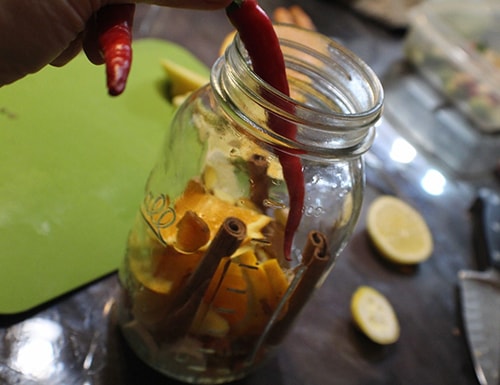
Step 3. Slice the citrus into ¼ pieces and peel the garlic cloves.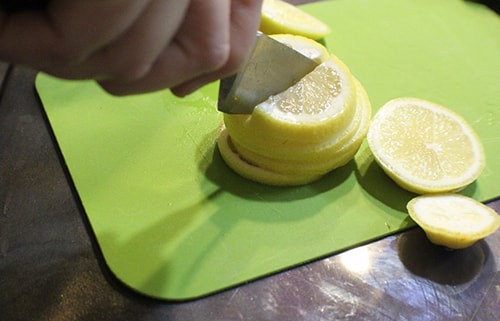
Step 4. Put the dry herbs in a small square of cheesecloth then tie it. Or add whole sprigs to the jar, standing up just like you did with the cinnamon and cayenne peppers.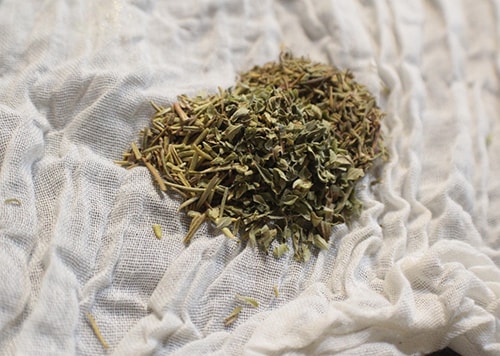
Step 5. Add the cheesecloth, remaining roots, garlic cloves and citrus pieces. Stay about an inch away from the jar’s rim.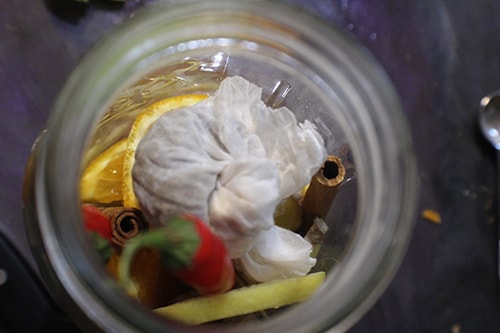
Step 6. Add the honey and vinegar. Fill the jar until all the ingredients are covered.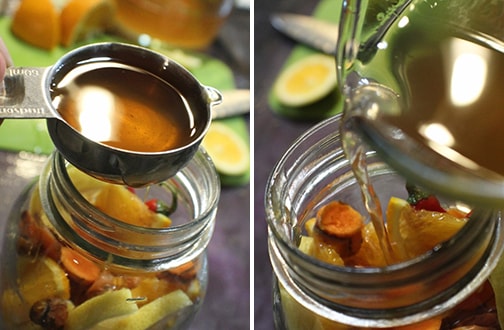
Step 7. For four weeks, keep the jar in a dry, cool place.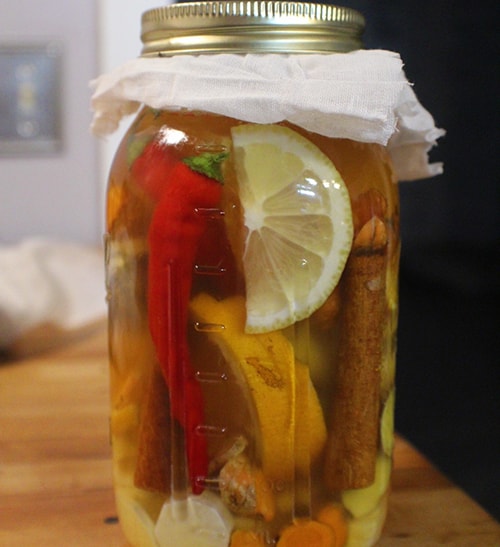
After four weeks, you can strain the vinegar into a new jar.
Take 1 -2 teaspoons of this illness protection potion daily. It can also be splashed on salads or used to make mixed tonics. And it should last in the refrigerator for up to six months… or about the duration of one cold and flu season!


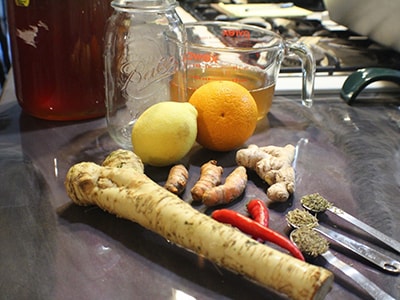

Why not just get a flu shot? Safe and effective right?
Thank you for yet another wholesome recipe.
As far as herbs go, I would not put them in a cheese cloth. You need let the herbs float freely. That way you extract more “juice” from them, making your fire cider more portent.
The safety and efficacy of flu shot/vaccine is debatable. Ultimately, there are usually four strains of the influenza virus that are included/susceptible in the most common vaccines, however there are more strains that circulate in any given population. This is why the flu shot is better some years than it is in other years.
As with so many things, our own health and safety is our own responsibility. Taking vaccines is -for most- a good idea. That said, the effect of many vaccines wears off over time and they are not 100% effective. Taking natural prevention treatments and natural remedies will only help one stay healthy, as long as we are using good ingredients just like the vaccine manufacturers. This recipe calls for herbs, fruits, and vegetables regularly found in our food.
The bottom-line is the responsibility of the companies selling the vaccines -and all other drugs. They make more money if the vaccine is effective for the season. They have an incentive to make it good, but many people will blindly get the flu shot regardless off efficacy…so they make their money anyway.
Really though, making our own remedies makes us feel good and gives a sense of autonomy and satisfaction…kind of like making your own meal.
There is no reason to dissuade this sort of practice.
*of note: I do get my flu shot every year. I am a registered nurse in a large hospital. The main reason that I choose to get my flu vaccine is because I have kids: if they get sick and I have to take care of two whiny sick kids, I need to know that I did everything I could to keep them healthy. I don’t need to be mad at myself for getting them sick.
Thank you for this recipe. I’m looking forward to making it.
If I can not find fresh Cayenne pepper, can De Arbol chili be used instead? Or shall I use the ground Cayenne pepper?
Hi Arya,
Both of the options you mentioned are good alternatives.
Many blessings and good health!
It says 6-8 piece of horseradish root. Is that 6-8” or slices? I cut up a 6 to 8 inch piece and put it in there, if I messed up I guess it will just be really really strong. I also made a double batch in a large jar, that should be fine, correct?
Also, I assume you do not put the solid piece of the lid on for the fermentation process? I put a paper towel, and then screw the hollow metal rim over it.
The picture shows the jar top covered with cheesecloth; did that mean we should let it ferment?
Hi Ted,
The jar is covered with cheesecloth to prevent any corrosion of the metal lid. You can also use plastic wrap or baking paper.
Many blessings and good health!
Can children take this? And if so, how much? My grandkids seem to get one thing after another in the winter (ages 3-5).
I don’t see where it tells how to cover the jar. I assume this is a ferment that needs to be able to breathe. Would a cotton cloth held with a rubberband work?
Turmeric and ginger roots can be very large or small. The amounts of both of these roots in the ingredient list seem to be very approximate therefore. I prefer amounts to be in weight, but I rarely see that.